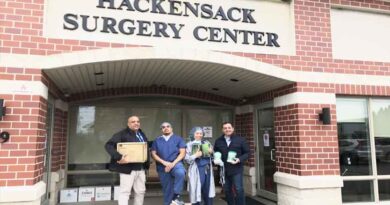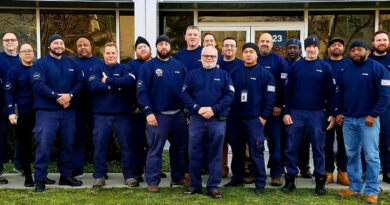Newark’s Approach to Police Reform and Community Building Might Be the Model for America
City of Newark Communications
In the exact spot where the rebellion of 1967 began more than half a century ago, Mayor Ras J. Baraka gave a name and a home to the work his administration has done in police reform and crime reduction. As he stood with Police Director Anthony Ambrose and Newark Corporation Counsel Kenyatta Stewart on that day in June, he signed into law a new ordinance creating the Office of Violence Prevention and Trauma Recovery, which will be housed in the former 4th Precinct (now the 1st), where cab driver John Smith was beaten by police 53 summers ago, sparking four days of the kind of conflicts that played out again in American cities this year. The creation of this office is just another example of the reforms and improvements in the Newark police and the violence suppression efforts of the community.
“This is a historic moment in the City of Newark,” the Mayor said. “Other cities have created these types of offices as ‘policy,’ but we have made it a law. I’m not going to be Mayor forever; people change and policies change, but it’s much harder to change a law.”
The new office will be funded by five percent of the Public Safety budget, as the Mayor acted while most people simply discussed “defunding the police” after the murder of George Floyd and the civil unrest that followed. The precinct building will be turned into a museum chronicling local activism in Newark and positive police changes, a trauma center for victim recovery and healing, workforce development, and headquarters for the Anti-Violence Initiative—all hallmarks of Mayor Baraka’s passion for equal justice, which began long before he took office.
“This is nothing new for us,” said Mayor Baraka, a founding member of the Newark Anti-Violence Coalition more than a decade ago. “When I was a South Ward Councilman, we demanded violence be looked at as a public health crisis.” The Mayor is also on the forefront of pushing for a Civilian Complaint Review Board that can subpoena police records and force officers involved in abuse complaints to testify. After winning in an appellate court earlier this year, the City was dealt a setback by the New Jersey Supreme Court, but the Mayor vows, “We will fight, and we will win.”
The City is planning appeals and is also behind state legislation that includes the abolition of qualified immunity for police. “We need Civilian Complaint Review Board legislation as well as police and fire residency requirements to ensure that those that police communities reflect the citizens they were sworn to protect.”
The Mayor’s innovations toward police reform and violence reduction began as soon as he took office as he organized “street team” activists to intervene in growing neighborhood tensions in the small sectors of the City where most of the violence occurs.
The results have been stunning. During his State of the City address last month, Mayor Baraka laid out the statistics. “In a four-year period from 2015 to 2019, we witnessed a 31 percent decrease in overall crime,” he said. “We entered office with 112 homicides and ended 2019 with 51. This is the lowest murder rate since 1961.” This was accomplished by a community approach to public safety, the Mayor said, citing “the unfettered and growing relationship with community-based organizations, alternative police strategies, and building community empathy and trust. Newark Community Street Team, Newark Street Academy, Newark Anti-Violence Coalition, Equal Justice USA, West Ward Victims Outreach, and all the organizations affiliated with Brick City Peace Collective.”
Director Ambrose and now-retired Chief Darnell Henry also advocate the 200-year-old philosophy of Sir Robert Peel that the “police are the community and the community are the police” and public safety is a cooperative effort, not the sole responsibility of an invading force. “When people have a friend or relative on the force, it humanizes the police,” Director Ambrose said. “Same with the community engagements.”
In that respect, the Newark police demographics today better reflect the community, with Black and Hispanic officers making up nearly 80 percent of the force, and the Newark Police hold close to 10,000 non-enforcement community engagements a year. These include holiday parties for kids, school visits, town hall meetings, meet-and-greets on the beat, a Citizen Clergy Academy, and a Hope One van offering helpful information for the homeless and drug addicted—all supported by the police budget.
During his State of the City address, Mayor Baraka also said Newark police had “become a part of an overall community-based strategy to reduce violence and crime and not the answer itself,” and because of these efforts there have been dramatic decreases in complaints and abuse cases.
“In 2010, the City had 857 citizen complaints, now we are at 271. Excessive force complaints dropped from 88 to 16. The cost of lawsuits dropped from over $1.3 million in 2010 to $51,000 in 2019 and since June 2019, the Newark Police Division had more than 2,000 business checks, 2,000 citizen contacts that did not involve a police action, 200 youth engagements that did not involve a police action, and attended more than 200 community meetings. The City frequently has community police roundtables and trauma circles and established new policies and training even before the mass protests began on use of force, de-escalation, implicit bias, and LGBTQ sensitivity.”
Director Ambrose said, “I think we are becoming a model police department. The City is becoming a model for the rest of the nation, and if they pay attention to what we’re doing here, they can solve a lot of their problems.” Two long-time activists agreed. “We will never again see a war on the people by police,” said historian Junius Williams. “We now have a combined operation between police and community to prevent crime.” Larry Hamm, who had protested police brutality for four decades, called Newark a model for “diverting police militarization funds to community solutions.”
In addition to greater community engagement, the police have undergone department-wide “search, seizure, and arrest” training to ensure Civil Rights; de-escalation training; bias perception training; and every patrol officer is equipped with a body-worn camera. In areas of accountability and transparency,the police document all stops, searches, and uses of excessive force — including the race of the subject — which are published on the Newark Public Safety webpage.
With the addition of the Office of Violence Prevention and Trauma Recovery, the City is also looking to help repair the trauma of all negative police encounters and violence. “This will be a place of healing,” said Lakeesha Eure, who serves as the director of the new office. “It will be a place of recovery for those touched by violence, and a place where we will develop a workforce of those who do the healing and those who prevent violence. It will be symbolic of the progress we’ve made as a peaceful community and the positive advances made by our police division to suppress crime by being engaged with the community, not alienated from it.”


